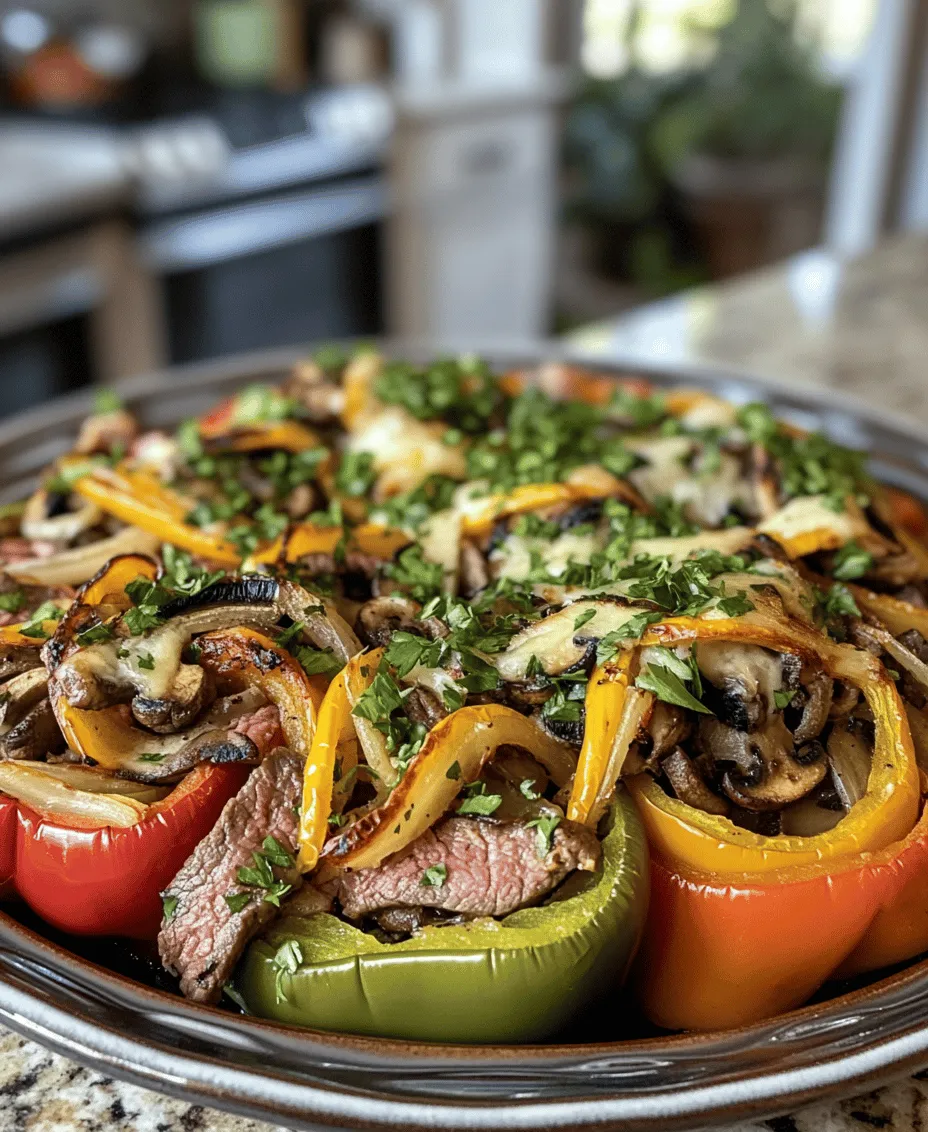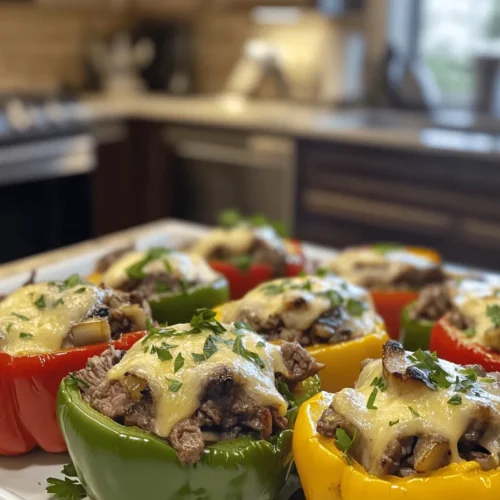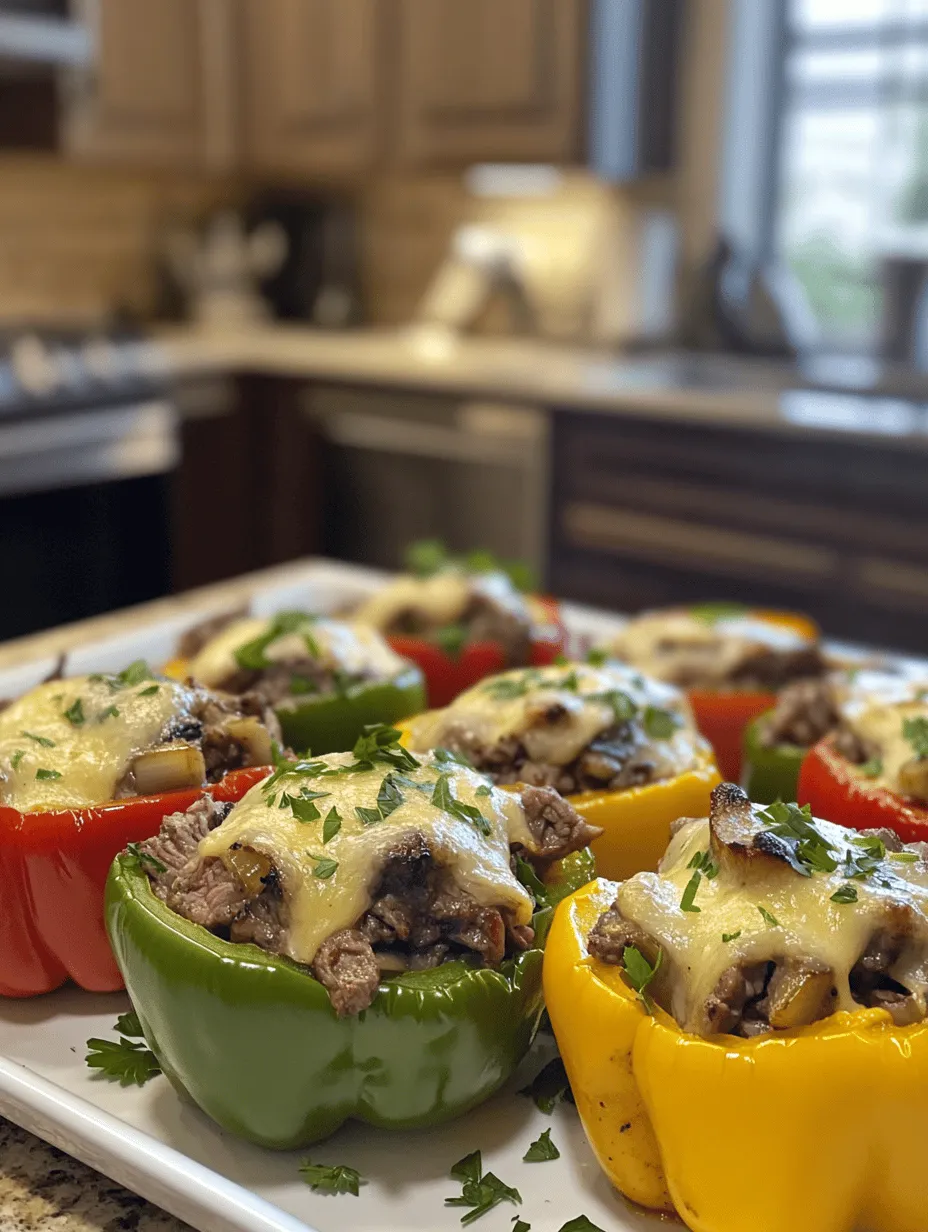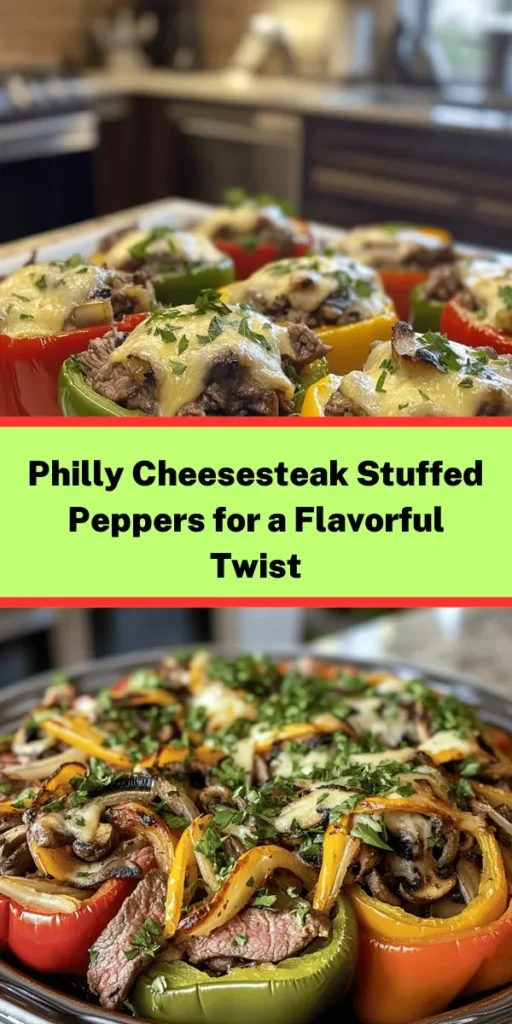In the realm of comfort food, few dishes can rival the hearty and indulgent experience of a classic Philly cheesesteak. Originating from the streets of Philadelphia, this iconic sandwich is loaded with thinly sliced ribeye steak, melted cheese, and sautéed onions, creating a flavor profile that is rich and satisfying. Now, imagine that flavorful sensation transformed into a healthy, colorful dish that’s not only visually appealing but also packed with nutrients. Enter Philly Cheesesteak Loaded Stuffed Peppers. This delightful recipe combines tender ribeye steak, sautéed vegetables, and gooey cheese, all nestled within vibrant bell peppers.
These stuffed peppers are not only a feast for the eyes but also an excellent way to incorporate more vegetables into your meals without sacrificing flavor. Whether you’re looking for a new family favorite or a dish to impress guests, these stuffed peppers deliver on taste and presentation. With their bold flavors and bright colors, Philly Cheesesteak Loaded Stuffed Peppers are sure to become a staple in your culinary repertoire.
Understanding the Ingredients
To create the perfect Philly Cheesesteak Loaded Stuffed Peppers, it’s essential to understand the core components of this dish. Each ingredient plays a unique role in contributing to the overall flavor and texture, ensuring that every bite is as delicious as the last.
Overview of Bell Peppers: Nutritional Benefits and Varieties
Bell peppers are the star of this dish, not only for their vibrant colors—ranging from green to red, yellow, and orange—but also for their nutritional benefits. They are low in calories and high in vitamins A and C, making them a healthy choice for any meal. The sweet and slightly tangy flavor of bell peppers complements the richness of the cheesesteak filling, creating a well-balanced dish.
When selecting bell peppers for this recipe, opt for larger ones that can easily hold a generous amount of filling. Red and yellow peppers are particularly sweet, while green peppers offer a slightly more bitter taste, which can provide a nice contrast to the savory filling.
Ribeye vs. Sirloin: Choosing the Right Cut of Meat
The meat is a crucial element in any cheesesteak dish, and for these stuffed peppers, ribeye steak is the preferred cut due to its tenderness and marbling. Ribeye has a rich flavor that becomes even more pronounced when cooked, making it an ideal choice for this recipe. However, if you prefer a leaner option, sirloin steak can also be used. While it may not have the same buttery texture as ribeye, it will still deliver a satisfying taste when seasoned and cooked properly.
The Role of Onions and Mushrooms in Flavor Development
Onions and mushrooms are traditional ingredients in a Philly cheesesteak, and they play a significant role in flavor development in this recipe as well. Onions add sweetness and depth, while mushrooms provide an earthy flavor that enhances the overall profile of the dish. When sautéed together, these vegetables create a delicious base that complements the richness of the steak and cheese.
Importance of Garlic in Enhancing Taste
Garlic is a flavor powerhouse that cannot be overlooked. Adding garlic to the sautéed vegetables elevates the taste, imparting a savory aroma that fills the kitchen as it cooks. Its pungent flavor balances the richness of the cheese and meat, ensuring that every bite is packed with deliciousness.
Cheese Choices: Provolone vs. Mozzarella
No cheesesteak is complete without cheese, and when it comes to stuffed peppers, you have options. Provolone cheese is the traditional choice for a Philly cheesesteak, known for its creamy texture and mild flavor. It melts beautifully, creating that gooey texture we all love. Alternatively, mozzarella cheese can be used for a slightly different taste and texture. It offers a stretchy, melty quality that pairs well with the other ingredients. Feel free to experiment with both cheeses or even a blend for a unique flavor experience.
The Significance of Worcestershire Sauce in the Recipe
Worcestershire sauce is a key ingredient that adds umami depth to the filling. This fermented liquid condiment brings a complex flavor profile, enhancing the savory notes of the steak and vegetables. A splash of Worcestershire sauce can make a significant difference in the overall taste, ensuring that your stuffed peppers are bursting with flavor.
Seasoning Essentials: Salt, Pepper, and Olive Oil
Simple seasoning is vital for bringing out the flavors of each ingredient. A generous sprinkle of salt and freshly ground black pepper will enhance the natural flavors of the meat and vegetables. Additionally, using high-quality olive oil for sautéing not only prevents sticking but also adds a subtle richness to the dish. These basic seasonings are the foundation upon which the other flavors build.
Step-by-Step Preparation Guide
With a clear understanding of the ingredients, it’s time to dive into the preparation of your Philly Cheesesteak Loaded Stuffed Peppers. This step-by-step guide will ensure that your cooking process is smooth and successful.
Preparation of the Bell Peppers for Stuffing
Before you start cooking, it’s essential to prepare the bell peppers properly. This involves removing the tops, seeds, and membranes to create a hollow space for the filling.
Preheating the Oven: Why Temperature Matters
Start by preheating your oven to 375°F (190°C). Preheating is crucial because it ensures that the peppers cook evenly and thoroughly. An adequately heated oven will also help the cheese melt beautifully, creating that irresistible gooey texture.
Proper Technique for Cutting and Cleaning Peppers
To prepare the bell peppers, use a sharp knife to slice off the tops, approximately one inch from the top. Make sure to reserve these tops; they can be chopped and added to the filling for extra flavor. Next, carefully remove the seeds and membranes from inside the peppers using your hands or a small spoon. Rinse the peppers under cold water to ensure they are clean, and set them aside to dry while you prepare the filling.
Cooking the Steak to Perfection
Once the peppers are prepped, it’s time to focus on the steak. Cooking the meat properly is essential for achieving the desired texture and flavor.
Tips for Achieving the Right Level of Doneness
For the best results, slice your ribeye steak against the grain into thin strips. This technique helps to maintain tenderness when cooked. In a large skillet over medium-high heat, add a drizzle of olive oil and let it heat until shimmering. Add the sliced steak to the skillet in a single layer, allowing it to sear without overcrowding the pan. Cook for about 2-3 minutes on each side, or until it reaches your desired level of doneness. For a medium-rare steak, aim for an internal temperature of 130-135°F (54-57°C).
Why Resting the Meat is Essential for Juiciness
Once cooked, remove the steak from the skillet and let it rest for at least 5 minutes. Resting allows the juices to redistribute throughout the meat, ensuring that every bite is juicy and flavorful. While the steak rests, you can move on to sautéing the vegetables.
Sautéing Vegetables: Creating a Flavor Base
The sautéed vegetables are where the magic happens, creating a flavor base that ties the entire dish together.
Importance of Cooking Order: Onions, Mushrooms, and Garlic
In the same skillet used for the steak, add a bit more olive oil if needed, and heat it over medium heat. Start by adding the sliced onions to the skillet, cooking them until they become translucent and slightly caramelized, about 5 minutes. Next, add the sliced mushrooms and sauté until they are tender and have released their moisture, about 3-4 minutes. Finally, stir in minced garlic and cook for an additional 1-2 minutes, or until fragrant. This order is crucial as it ensures that each vegetable reaches its optimal texture and flavor.
How to Achieve the Ideal Texture in Vegetables
You want your vegetables to be tender but still retain a bit of bite. Overcooking can lead to mushiness, so keep a close eye on them and stir occasionally to promote even cooking. Once the vegetables are perfectly sautéed, combine them with the rested steak in a mixing bowl.
Combining Ingredients for Maximum Flavor
With all components prepared, it’s time to bring everything together for the final filling.
Techniques for Mixing Ingredients Thoroughly
In the mixing bowl, add the sautéed vegetables to the sliced steak, then drizzle in Worcestershire sauce, and season with salt and pepper to taste. Gently fold the ingredients together until well combined, ensuring that the flavors meld harmoniously. This filling is what will make your stuffed peppers truly shine, so take the time to mix thoroughly.
Now that you’ve prepped the ingredients and created a delicious filling, you are ready to stuff the bell peppers and complete this culinary masterpiece. Stay tuned for the next part, where we’ll delve into the final steps of assembling and baking the Philly Cheesesteak Loaded Stuffed Peppers!

Best Practices for Ensuring Even Distribution of Ingredients
When preparing Philly Cheesesteak Loaded Stuffed Peppers, ensuring an even distribution of ingredients is crucial for maintaining flavor balance in every bite. Here are some techniques to help you pack your peppers effectively:
Stuffing the Peppers: Techniques for Packing
1. Layering Ingredients: Start by layering your ingredients as you stuff the peppers. Begin with a spoonful of the meat mixture at the bottom, followed by a sprinkle of veggies, and then add cheese. Repeat this process to create distinct layers within the pepper. This method not only helps with even distribution but also enhances the overall flavor profile.
2. Use a Spoon or Small Cup: To pack the stuffing, use a spoon or a small cup to press down the filling gently. This allows you to fill the peppers more densely without tearing them. Be careful not to overstuff; you want the filling to be snug but not overflowing.
3. Tap and Shake: After adding the stuffing, gently tap the peppers on a flat surface. This encourages the filling to settle and helps to eliminate any air pockets that may cause uneven cooking.
How to Avoid Overstuffing or Underpacking Peppers
Overstuffing can lead to peppers bursting during cooking, while underpacking can result in a dry texture. Aim for a good balance by following these guidelines:
– Fill to the Top: Stuff the peppers until the filling is just above the rim. This will allow for expansion during baking without risking overflow.
– Check for Resistance: When packing, if you feel significant resistance while pushing the filling down, it is a sign that you may need to reduce the amount of stuffing.
Visual Cues to Look for When Stuffing
As you pack your peppers, keep an eye out for these visual cues:
– Shape Maintenance: The peppers should maintain their natural shape without bulging excessively.
– Visible Filling: The filling should be visible but not spilling over. If you can see the stuffing peeking out, you’re in a good place.
Cheese Application: Timing and Techniques
Cheese is a key component of Philly Cheesesteak Loaded Stuffed Peppers, and getting it right is vital for achieving that gooey, melty texture that everyone loves.
Why Cheese Should be the Final Layer
Adding cheese as the final layer serves several purposes:
– Melting Perfection: Placing cheese on top allows it to melt while the peppers cook, creating a delicious crust.
– Flavor Enhancement: The melted cheese forms a cohesive layer that helps bind the flavors of the stuffing, enhancing the overall taste of the dish.
Tips for Achieving the Perfect Melt
To achieve the perfect melted cheese, consider these tips:
– Use Shredded Cheese: Shredded cheese melts more evenly than blocks. Opt for a blend of provolone and mozzarella for a rich flavor.
– Cover with Foil: For the first part of the baking process, cover the stuffed peppers with foil. This will trap moisture and help the cheese melt smoothly without burning.
– Finish Uncovered: Remove the foil during the last 10-15 minutes of baking to allow the cheese to brown and bubble.
Baking the Stuffed Peppers
Baking techniques are essential for ensuring your stuffed peppers are cooked thoroughly and taste delicious.
Understanding Baking Techniques for Optimal Results
1. Preheat Your Oven: Always preheat your oven to ensure even cooking from the moment the peppers go in.
2. Use a Baking Dish: Place the stuffed peppers upright in a baking dish. If they tend to tip over, you can fill the bottom of the dish with a bit of water or broth to help stabilize them.
The Importance of Covering with Foil
Covering the stuffed peppers with foil during the first half of baking helps trap steam. This leads to evenly cooked peppers that are tender but not mushy. It also prevents the cheese from burning before the peppers are done.
How to Determine When Stuffed Peppers are Done
Cook time can vary based on your oven and the size of the peppers, but here are some indicators to look for:
– Tenderness: The peppers should be tender when pierced with a fork.
– Cheese Bubbling: Look for bubbly, golden-brown cheese on top.
– Internal Temperature: If you have a meat thermometer, the internal temperature of the filling should reach 165°F (75°C).
Serving Suggestions and Presentation
The way you present your Philly Cheesesteak Loaded Stuffed Peppers can enhance your meal’s overall appeal.
Garnishing for Visual Appeal
1. Fresh Parsley: A sprinkle of freshly chopped parsley not only adds a pop of color but also a fresh flavor that complements the richness of the dish.
2. Drizzle of Sauce: Consider drizzling a bit of balsamic reduction or a spicy aioli for an extra layer of flavor and visual interest.
Creative Serving Ideas for Family Meals and Gatherings
– Family Style: Serve the stuffed peppers on a large platter, allowing everyone to help themselves. This approach fosters a communal dining experience.
– Individual Portions: For a more elegant touch, serve each stuffed pepper on a small plate with a side of dipping sauce.
Pairing Options to Complement Your Dish
Suggested Side Dishes that Work Well with Stuffed Peppers
– Simple Salad: A light green salad with a tangy vinaigrette can balance the richness of the stuffed peppers.
– Garlic Bread: Serve with warm garlic bread for a comforting touch that complements the meal perfectly.
Beverage Pairings: What to Serve with Your Meal
– Wine: A medium-bodied red wine, such as a Cabernet Sauvignon or Merlot, pairs beautifully with the savory flavors of the stuffed peppers.
– Beer: For beer lovers, a crisp lager or pale ale can enhance the meal without overpowering the flavors.
Nutritional Value of Philly Cheesesteak Loaded Stuffed Peppers
Understanding the nutritional components of your meal can help you make informed choices.
Breaking Down the Nutritional Components
– Calories and Macronutrients: On average, a serving of Philly Cheesesteak Loaded Stuffed Peppers contains approximately 350-450 calories, depending on the amount of cheese and meat used.
– Protein-Rich: The use of lean beef or chicken provides a hearty dose of protein, making it a satisfying meal option.
Health Benefits of Ingredients Used in the Recipe
– Bell Peppers: Rich in vitamins A and C, bell peppers are low in calories and high in fiber, making them an excellent choice for a healthy meal.
– Lean Meat: Using lean cuts of beef or chicken helps reduce saturated fat intake while providing essential nutrients like iron and vitamin B12.
Conclusion: The Allure of Philly Cheesesteak Loaded Stuffed Peppers
Incorporating the flavors of a classic cheesesteak into a healthy, stuffed pepper format creates a delightful dish that satisfies cravings without compromising on nutrition. This recipe is not just a meal; it’s a celebration of flavors, textures, and colors, all while being easy to prepare and perfect for any occasion. Whether enjoyed as a weeknight dinner or a festive gathering, Philly Cheesesteak Loaded Stuffed Peppers are bound to become a beloved staple in your culinary repertoire. These stuffed peppers pack a punch of flavor and offer a healthier twist on a classic favorite, making them a fantastic option for family dinners or entertaining guests. Enjoy your culinary adventure and savor every delicious bite!



